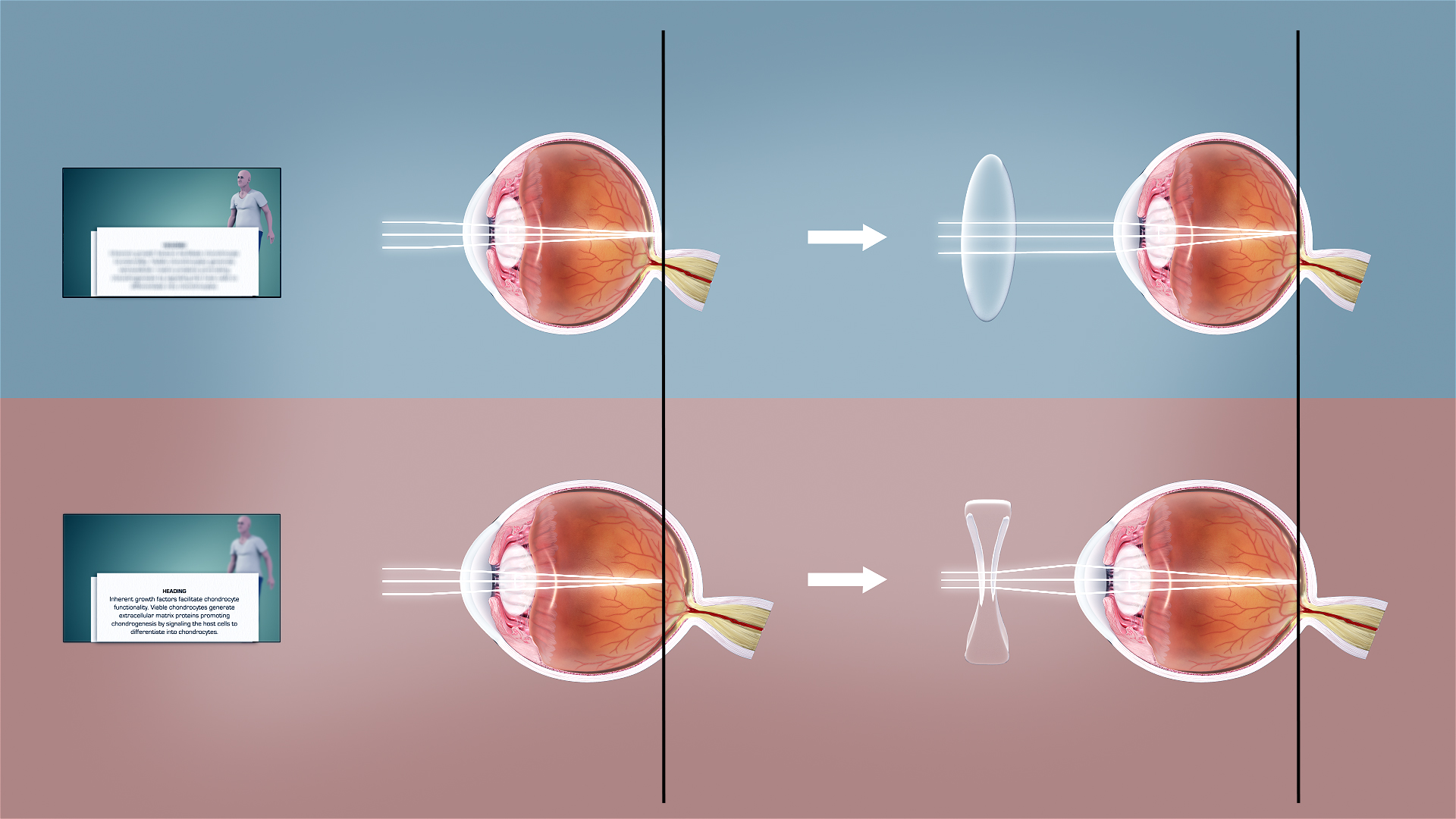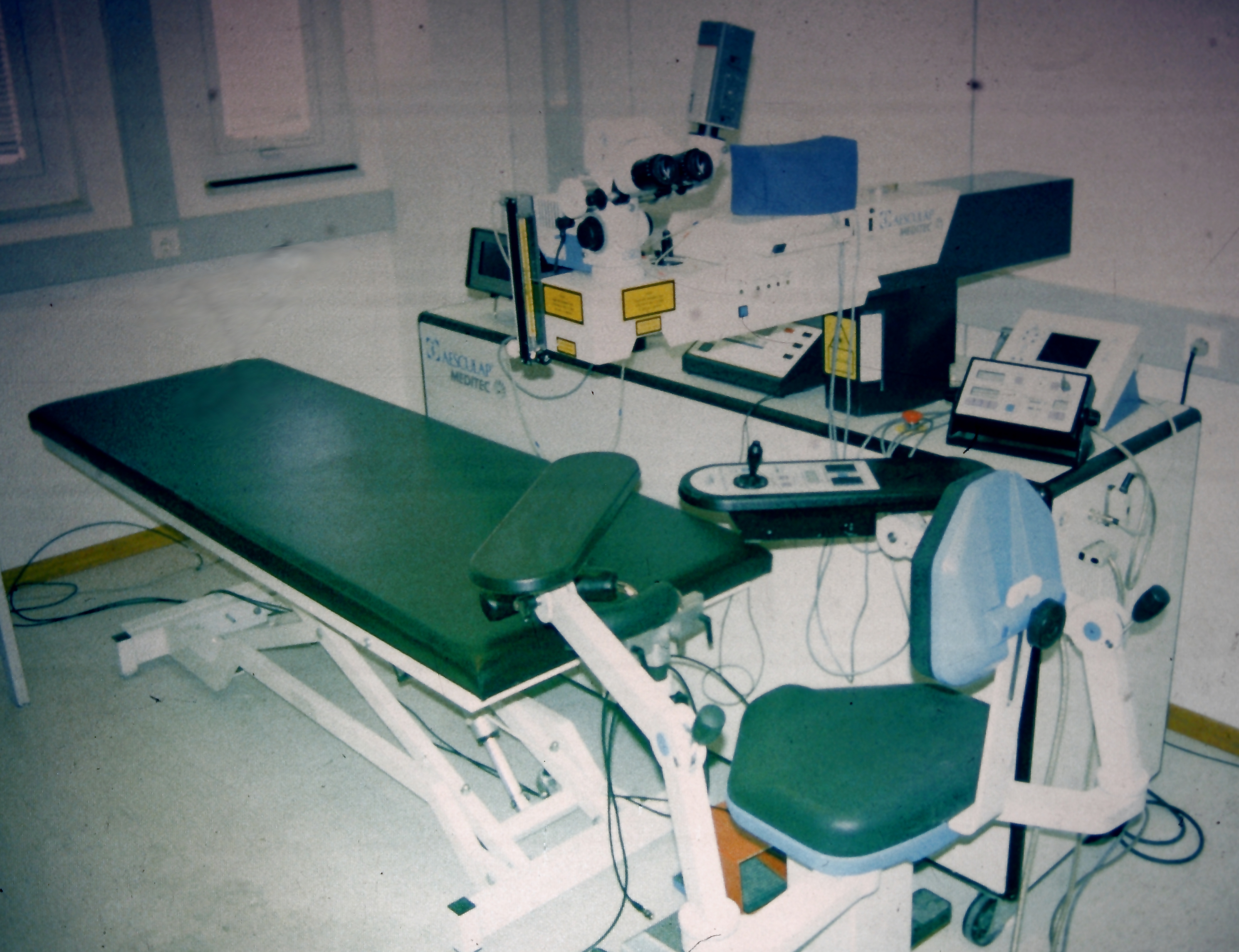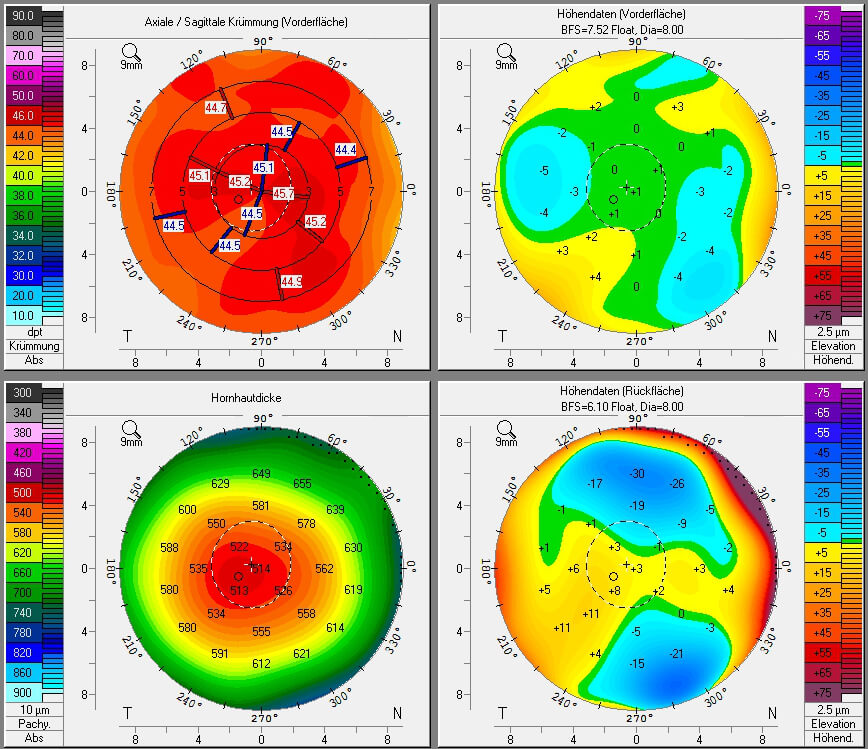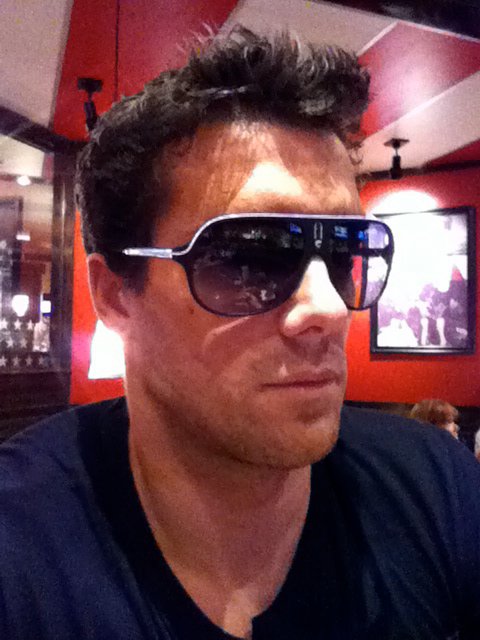|
Myopia
Myopia, also known as near-sightedness and short-sightedness, is an eye condition where light from distant objects focuses in front of, instead of on, the retina. As a result, distant objects appear blurry, while close objects appear normal. Other symptoms may include headaches and eye strain. Severe myopia is associated with an increased risk of macular degeneration, retinal detachment, cataracts, and glaucoma. Myopia results from the length of the eyeball growing too long or less commonly the lens being too strong. It is a type of refractive error. Diagnosis is by the use of cycloplegics during eye examination. Tentative evidence indicates that the risk of myopia can be decreased by having young children spend more time outside. This decrease in risk may be related to natural light exposure. Myopia can be corrected with eyeglasses, contact lenses, or by refractive surgery. Eyeglasses are the simplest and safest method of correction. Contact lenses can provide a rela ... [...More Info...] [...Related Items...] OR: [Wikipedia] [Google] [Baidu] |
Refractive Error
Refractive error is a problem with focus (optics), focusing light accurately on the retina due to the shape of the eye and/or cornea. The most common types of refractive error are myopia, near-sightedness, hyperopia, far-sightedness, astigmatism, and presbyopia. Near-sightedness results in far away objects being blurred vision, blurry, far-sightedness and presbyopia result in close objects being blurry, and astigmatism causes objects to appear stretched out or blurry. Other symptoms may include double vision, headaches, and eye strain. Near-sightedness is due to the length of the eyeball being too long; far-sightedness the eyeball too short; astigmatism the cornea being the wrong shape, while presbyopia results from aging of the lens of the eye such that it cannot change shape sufficiently. Some refractive errors occur more often among those whose parents are affected. Diagnosis is by eye examination. Refractive errors are corrected with eyeglasses, contact lenses, or surgery ... [...More Info...] [...Related Items...] OR: [Wikipedia] [Google] [Baidu] |
LASIK
LASIK or Lasik (; "laser-assisted in situ keratomileusis"), commonly referred to as laser eye surgery or laser vision correction, is a type of refractive surgery for the correction of myopia, hyperopia, and astigmatism. LASIK surgery is performed by an ophthalmologist who uses a femtosecond laser or a microkeratome to create a corneal flap to expose the corneal stroma and then an excimer laser to reshape the corneal stroma in order to improve visual acuity. LASIK is very similar to another surgical corrective procedure, photorefractive keratectomy (PRK), and LASEK. All represent advances over radial keratotomy in the surgical treatment of refractive errors of vision. For people with moderate to high myopia or thin corneas which cannot be treated with LASIK or PRK, the phakic intraocular lens is an alternative. As of 2018, roughly 9.5 million Americans have had LASIK and, globally, between 1991 and 2016, more than 40 million procedures were performed. However, the ... [...More Info...] [...Related Items...] OR: [Wikipedia] [Google] [Baidu] |
Refractive Surgery
Refractive surgery is an optional eye surgery used to improve the refractive state of the eye and decrease or eliminate dependency on glasses or contact lenses. This can include various methods of surgical remodeling of the cornea ( keratomileusis), lens implantation or lens replacement. The most common methods today use excimer lasers to reshape the curvature of the cornea. Refractive eye surgeries are used to treat common vision disorders such as myopia, hyperopia, presbyopia and astigmatism. History The first theoretical work on the potential of refractive surgery was published in 1885 by Hjalmar August Schiøtz, an ophthalmologist from Norway. In 1930, the Japanese ophthalmologist Tsutomu Sato made the first attempts at performing this kind of surgery, hoping to correct the vision of military pilots. His approach was to make radial cuts in the cornea, correcting effects by up to 6 diopters. The procedure unfortunately produced a high rate of corneal degeneration, ... [...More Info...] [...Related Items...] OR: [Wikipedia] [Google] [Baidu] |
Photorefractive Keratectomy
Photorefractive keratectomy (PRK) and laser-assisted sub-epithelial keratectomy (or laser epithelial keratomileusis) (LASEK) are laser eye surgery procedures intended to correct a person's vision, reducing dependency on glasses or contact lenses. LASEK and PRK permanently change the shape of the anterior central cornea using an excimer laser to ablate (remove by vaporization) a small amount of tissue from the corneal stroma at the front of the eye, just under the corneal epithelium. The outer layer of the cornea is removed prior to the ablation. A computer system tracks the patient's eye position 60 to 4,000 times per second, depending on the specifications of the laser that is used. The computer system redirects laser pulses for precise laser placement. Most modern lasers will automatically center on the patient's visual axis and will pause if the eye moves out of range and then resume ablating at that point after the patient's eye is re-centered. The outer layer of the corne ... [...More Info...] [...Related Items...] OR: [Wikipedia] [Google] [Baidu] |
Eyeglass
Glasses, also known as eyeglasses (American English), spectacles ( Commonwealth English), or colloquially as specs, are vision eyewear with clear or tinted lenses mounted in a frame that holds them in front of a person's eyes, typically utilizing a bridge over the nose and hinged arms, known as temples or temple pieces, that rest over the ears for support. Glasses are typically used for vision correction, such as with reading glasses and glasses used for nearsightedness; however, without the specialized lenses, they are sometimes used for cosmetic purposes. Safety glasses are eye protection, a form of personal protective equipment ( PPE) that are worn by workers around their eyes for protection. Safety glasses act as a shield to protect the eyes from any type of foreign debris that may cause irritation or injury; these glasses may have protection on the sides of the eyes as well as in the lenses. Some types of safety glasses are used to protect against visible and ... [...More Info...] [...Related Items...] OR: [Wikipedia] [Google] [Baidu] |
Retinal Detachment
Retinal detachment is a condition where the retina pulls away from the tissue underneath it. It may start in a small area, but without quick treatment, it can spread across the entire retina, leading to serious vision loss and possibly blindness. Retinal detachment is a medical emergency that requires surgery. The retina is a thin layer at the back of the eye that processes visual information and sends it to the brain. When the retina detaches, common symptoms include seeing floaters, flashing lights, a dark shadow in vision, and sudden blurry vision. The most common type of retinal detachment is rhegmatogenous, which occurs when a tear or hole in the retina lets fluid from the center of the eye get behind it, causing the retina to pull away. Rhegmatogenous retinal detachment is most commonly caused by posterior vitreous detachment, a condition where the gel inside the eye breaks down and pulls on the retina. Risk factors include older age, nearsightedness ( myopia), eye injury, ... [...More Info...] [...Related Items...] OR: [Wikipedia] [Google] [Baidu] |
Blurred Vision
Blurred vision is an ocular symptom where vision becomes less precise and there is added difficulty to resolve fine details. Temporary blurred vision may involve dry eyes, eye infections, alcohol poisoning, hypoglycemia, or low blood pressure. Other medical conditions may include refractive errors such as myopia, high hypermetropia, and astigmatism, amblyopia, presbyopia, pseudomyopia, diabetes, cataract, pernicious anemia, vitamin B12 deficiency, thiamine deficiency, glaucoma, retinopathy, hypervitaminosis A, migraine, sjögren's syndrome, floater, macular degeneration, and can be a sign of stroke or brain tumor. __TOC__ Causes There are many causes of blurred vision: * Refractive errors: Uncorrected refractive errors like myopia, high hypermetropia, and astigmatism will cause distance vision blurring. It is one of the leading cause of visual impairment worldwide. Unless there is no associated amblyopia, visual blur due to refractive errors can be corrected to n ... [...More Info...] [...Related Items...] OR: [Wikipedia] [Google] [Baidu] |
Implantable Collamer Lens
A phakic intraocular lens (PIOL) is an intraocular lens that is implanted surgically into the eye to correct refractive errors without removing the natural lens (also known as "phakos", hence the term). Intraocular lenses that are implanted into eyes after the eye's natural lens has been removed during cataract surgery are known as pseudophakic. Phakic intraocular lenses are indicated for patients with high refractive errors when the usual laser options for surgical correction (LASIK and PRK) are contraindicated. Phakic IOLs are designed to correct high myopia ranging from −5 to −20 D if the patient has enough anterior chamber depth (ACD) of at least 3 mm. Three types of phakic IOLs are available: * Angle-supported * Iris-fixated * Sulcus-supported intraocular lens Medical uses LASIK can correct myopia up to -12 to -14 D. The higher the intended correction the thinner and flatter the cornea will be post-operatively. For LASIK surgery, one has to preserve a safe ... [...More Info...] [...Related Items...] OR: [Wikipedia] [Google] [Baidu] |
Retinal Detachment
Retinal detachment is a condition where the retina pulls away from the tissue underneath it. It may start in a small area, but without quick treatment, it can spread across the entire retina, leading to serious vision loss and possibly blindness. Retinal detachment is a medical emergency that requires surgery. The retina is a thin layer at the back of the eye that processes visual information and sends it to the brain. When the retina detaches, common symptoms include seeing floaters, flashing lights, a dark shadow in vision, and sudden blurry vision. The most common type of retinal detachment is rhegmatogenous, which occurs when a tear or hole in the retina lets fluid from the center of the eye get behind it, causing the retina to pull away. Rhegmatogenous retinal detachment is most commonly caused by posterior vitreous detachment, a condition where the gel inside the eye breaks down and pulls on the retina. Risk factors include older age, nearsightedness ( myopia), eye injury, ... [...More Info...] [...Related Items...] OR: [Wikipedia] [Google] [Baidu] |
Contact Lenses
Contact lenses, or simply contacts, are thin lens (optics), lenses placed directly on the surface of the Human eye, eyes. Contact lenses are ocular prosthetic devices used by over 150 million people worldwide, and they can be worn to corrective lens, correct vision or for cosmetics, cosmetic or therapeutic reasons. In 2010, the worldwide market for contact lenses was estimated at $6.1 billion, while the US soft lens market was estimated at $2.1 billion.Nichols, Jason J., et a"ANNUAL REPORT: Contact Lenses 2010" January 2011. Multiple analysts estimated that the global market for contact lenses would reach $11.7 billion by 2015. the average age of contact lens wearers globally was 31 years old, and two-thirds of wearers were female.Morgan, Philip B., et al"International Contact Lens Prescribing in 2010" ''Contact Lens Spectrum''. October 2011. People choose to wear contact lenses for many reasons. Aesthetics and cosmetics are main motivating factors for people who want to avo ... [...More Info...] [...Related Items...] OR: [Wikipedia] [Google] [Baidu] |
Optometry
Optometry is the healthcare practice concerned with examining the eyes for visual defects, prescribing corrective lenses, and detecting eye abnormalities. In the United States and Canada, optometrists are those that hold a post-baccalaureate four-year Doctor of Optometry degree. They are trained and licensed to practice medicine for eye related conditions, in addition to providing refractive (optical) eye care. Within their scope of practice, optometrists are considered physicians and bill medical insurance(s) (example: Medicare) accordingly. In the United Kingdom, optometrists may also provide medical care (e.g. prescribe medications and perform various surgeries) for eye-related conditions in addition to providing refractive care. The Doctor of Optometry degree is rarer in the UK. Many optometrists participate in academic research for eye-related conditions and diseases. In addition to prescribing glasses and contact lenses for vision related deficiencies, optometrists are ... [...More Info...] [...Related Items...] OR: [Wikipedia] [Google] [Baidu] |





